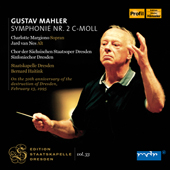
ESSENTIAL RECORDINGS

Conductor Bernard Haitink has recorded Gustav Mahler's Symphony No. 2 in C minor
many times before, with some of the top orchestras including the Royal Concertgebouw, Chicago, Berlin ... and has most likely been at the helm of
countless live performances during his illustrious career. Needless to say that this work, along with many others, is probably etched on his mind by now,
and this "live" take clearly demonstrates his inherent ability to mold and shape this music as the mood or occasion dictate. And the members of the
Staatskapelle Dresden as well as the Dresden Symphony Choir are more than willing to oblige. As in most "live"
productions, some passages may lack a bit of ensemble impact, or suffer from a lapse in communal momentum, but all things considered it is a solid
and moving performance befitting the commemorative ceremony it was addressing.
For the first time on February 13, 1995, the 50th anniversary of the destruction of Dresden, a requiem was not performed. Instead, Gustav
Mahler's Second Symphony was presented - in the conviction that it is perhaps the only work in the symphonic repertoire that might do justice
to the spirit of the day; in the live recording presented here, the listener may perhaps even sense something of the special atmosphere prevailling
at that concert. Composed and premièred well over 100 years ago, this symphony is the work of a composer who not only suffered from the inner
turmoil prevailling in the art and the society of his time, but who also seems to have felt and set to music his grim foreboding of 20th century conflict.
It is not surprising that people have become ever more open to his messages since the horror of the Second World War. Seen in this light, Mahler's
music not only leads back to the year 1945, but also beyond it - in keeping with the spirit of every performance on Dresden's commemoration day -
to all those people who live in war and terror, threatened and in fear. And it brings us all hope for the future.
There has been no applause at these concerts since 1951, neither at the entrance of the musicians nor at the end of the performance. This quiet atmosphere,
in which the performers and the audience silently rise to their feet at the end to join in remembrance and then quietly depart, is a deeply moving
experience for all present. No final applause after Mahler's Second Symphony, after such a finale? Is it possible for people to exercise such restraint?
On this occasion, it was, and the effect was breathtaking; it was an unforgettable experience. {Eberhard Steindorf - Profil}
Taken at a generally more relaxed pace than most, and even slightly slower than his own previous "live" take with Chicago, it allows for more orchestral
detail to show through and permits the major climactic moments to fully bloom. 14:25 into the first movement is a good example. And 15:12 is even
better - it will take your breath away. Kudos to the tympanist leading to that point. The final two and a half minutes of the movement are exemplary
and clearly convey the music's intent. The Scherzo movement is crawling with details, and its apocalyptic outcry at the 9:06 mark will take you aback.
Jard van Nes' delivery of the wonderful three rising notes that open the Urlicht fourth movement is goosebump
inducing, and her orchestral support throughout this movement has a glow all its own. The massive cry of anger that opens the final movement is
one of the best I've heard and sets the stage for a memorable finale. The off-stage horns present the right perspective, especially for a live performance.
The first major glimpse of heaven at the 8:17 mark is truly uplifting, and the massive crescendo drum roll that follows will make you feel like you should
run for cover. The rising of the dead and their relentless march to the final judgement is impressive in its impact. The choir's initial entry is quiet, but
doesn't quite sound distant enough (something that must be difficult to pull off in a live setting). Soprano Charlotte Margiono's
voice soars high over the choir and leads the way forward. The soprano and mezzo duo is performed with conviction from both parties, and the ensuing
choral crescendo has plenty of weight and impact. Unfortunately, the pipe organ is inaudible at this crucial moment, but the orchestral forces more
than make up for it. The emotional impact of the closing moments is tangible in the dead silence that follows the final chord.
This may not be the absolute best Mahler Second I've heard (although I think I've heard too many by now to really be able to make an accurate comparison),
but the emotional impetus and nervous energy behind this "live" war spawned event lifts it up high and makes me regret that I wasn't in Dresden on that day
to witness it firsthand.
Jean-Yves Duperron - June 2012